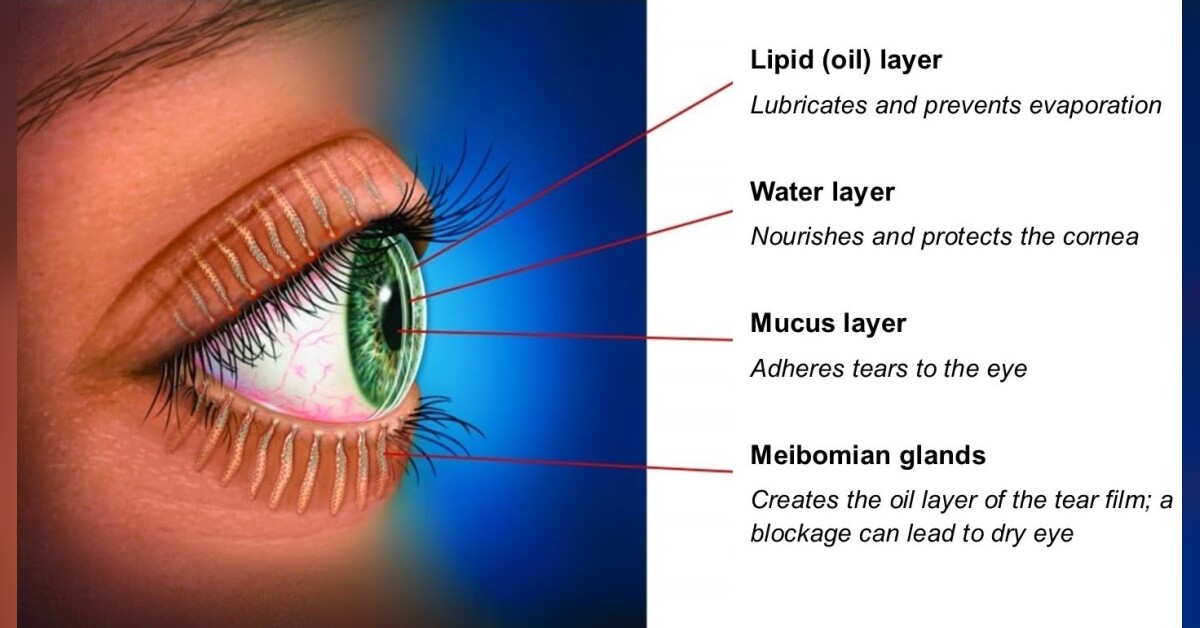Your eyes require a constant flow of tears to stay healthy and comfortable. If your eyes fail to make enough tears or if your eyes don’t make the right type of tears, you may have an irritating condition called dry eye.
July is National Dry Eye Awareness Month, so let’s take a look at the ailment in detail.
Every time you blink, a thin film of tears spreads across your eye to keep its surface smooth and clear. The tear film is made up of three layers: an oil layer for lubrication, a water layer for moisture and a mucus layer to make tears adhere to the surface of the eyes. While each layer serves an important purpose, oil and water are the most important components of the tear film.
You must have the right balance of oil and water to maintain a healthy tear film. Without oil, which is produced and released by the meibomian glands in the eyelids, the tear film becomes unstable and fails to spread evenly across the eye’s surface. As a result, the tears evaporate more quickly, resulting in dry eye. The meibomian glands can malfunction due to blockages of debris and hardened oil.
There are other potential causes for dry eye as well. Certain diseases, including rheumatoid arthritis, Sjogren’s syndrome, thyroid disease and lupus, can lead to dry eye. Being in smoky, windy or dry environments can contribute to the condition. Hormonal changes, such as those during menopause, are linked to dry eye, which may be why dry eye is nearly twice as common in women than in men.

Looking at computers and other digital devices for extended periods can cause dry eye because we tend to blink less when staring at screens. Wearing contact lenses for a long time or having had LASIK or cataract surgery can promote dry eye. Certain medications, including some antihistamines, diuretics, antidepressants and blood pressure medicines, can also dry your eyes.
Dry eye is a common condition. According to the National Eye Institute, nearly 16 million Americans have dry eye. Other sources suggest that as many as 48 percent of adult Americans regularly experience dry eye symptoms.
Symptoms include stinging and burning, fluctuating or blurred vision, a scratchy or gritty feeling like something is in your eye, redness or irritation, pain when wearing contact lenses, eye fatigue, light sensitivity, stringy mucus near your eyes, and an excess of tears.
Having lots of tears may seem odd when you have dry eye, but your eyes make more tears when they are irritated by dry eye.
Untreated, chronic dry eye can lead to serious complications, including eye infections, eye inflammation, abrasions of the corneal surface, corneal ulcers and vision loss. The cornea is the clear outer layer at the front of your eye.
To diagnose the condition, your doctor will first ask about your symptoms and general health, any medications you take and any environmental conditions you experience that may be contributing to your dry eye. The doctor will then perform a comprehensive exam to evaluate the surface of your eyes. The exam will likely include tests to measure the quantity and quality of your tears and an observation of tear flow and evaporation rate.
Treatment aims to keep the eyes well lubricated and prevent vision from being affected. The treatment approach taken depends on the severity of the condition. Mild cases can often be managed using over-the-counter artificial tears as needed to supplement natural tear production. Preservative-free preparations are recommended.
If your dry eye is more serious, your doctor may prescribe a medication such as cyclosporine (RESTASIS®, CEQUA™) or lifitegrast (XIIDRA®). These eyedrops are used twice a day to reduce inflammation and relieve the symptoms of dry eye.
To conserve the natural tears on the surface of your eyes, your doctor may recommend placing tiny silicone or gel-like plugs, called punctal plugs, to block the ducts that drain the tears. In extreme cases, surgery to permanently close the ducts may be performed.
Your doctor may recommend other treatments, such as intense-pulsed light (IPL) and the LipiFlow® Thermal Pulsation System.
Light energy from IPL warms the meibomian glands and any material clogging them. This allows the oil to flow normally from the glands into the tear film.
LipiFlow combines the controlled application of therapeutic heat with a gentle, pulsating massage. These functions work to liquify, then remove the clogging debris from the meibomian glands, enabling them to function efficiently.
A scleral lens is another way to keep the natural moisture on the eyes. This is a special contact lens that rests on the sclera, the white part of the eye. It creates a fluid-filled layer over the cornea, preventing it from drying out.
There are some steps you can take to improve dry eye. Humidify your bedroom to keep moisture in the air. Take frequent breaks when using a computer or other digital device. Wear wrap-around sunglasses when outside to protect your eyes from the wind and sun. Avoid dehydration by drinking eight to 10 glasses of water each day. Keep air from being blown directly into your eyes. Direct fans and car heaters away from your face.
And finally, use your artificial tears and/or prescription eyedrops as recommended by your doctor.
Patti DiPanfilo




Leave a Reply